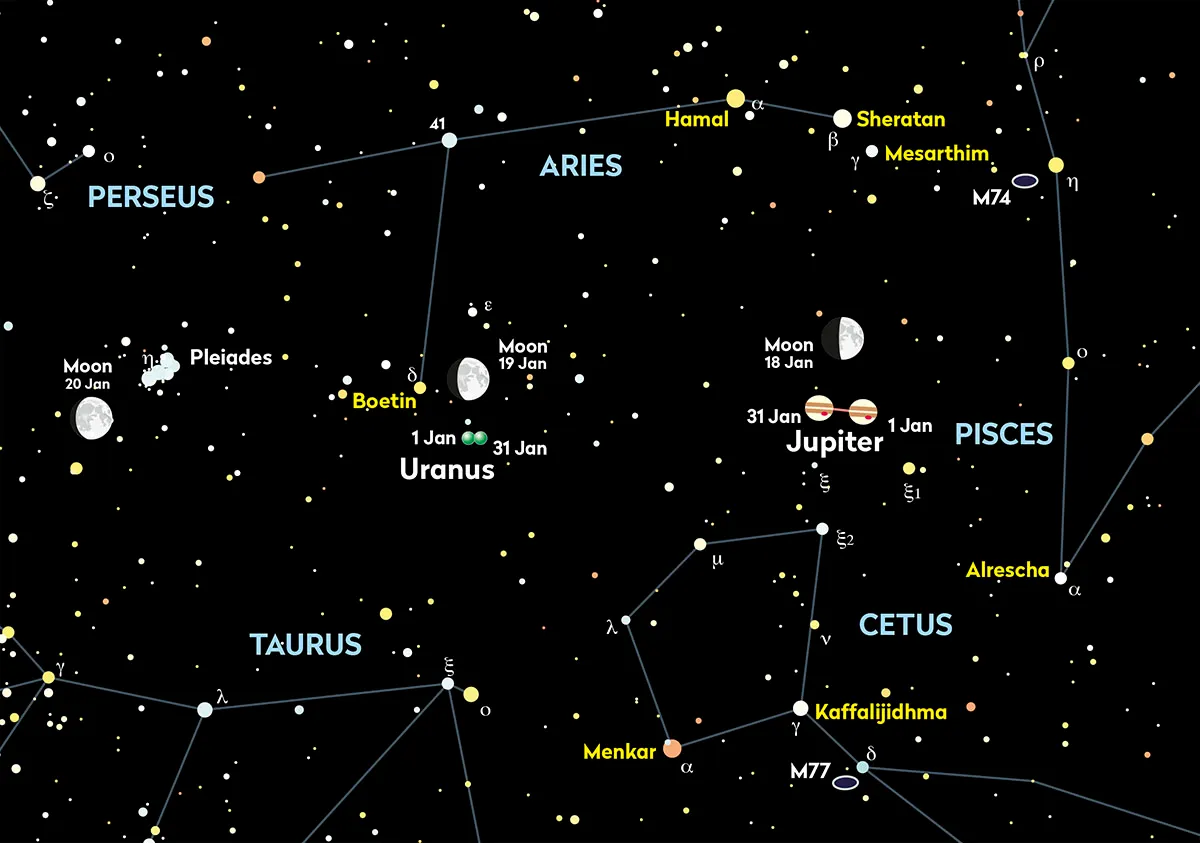Jupiter is well placed at the start of January 2024, and is our pick of the planets for the month, although towards the end of the month it will begin to disappear from view.
Shining at mag. –2.4, the planet will appear a disc full of detail with an apparent diameter of 43 arcseconds at the start of January 2024.
Use a small telescope to see its disc, with Jupiter's iconic banding clearly visible.

A 100mm or larger scope will show Jupiter's storm feature known as the Great Red Spot.
Also take time to see Jupiter's Galilean Moons, which are easily seen through a small telescope.
For more advice, read our guide on how to observe Jupiter through a telescope.
Below is our summary of planets visible in January 2024.

Jupiter
- Best time to see: 1 January, 19:40 UT
- Altitude: 49°
- Location: Aries
- Direction: South
- Features: Complex atmosphere, Galilean moons
- Recommended equipment: 75mm or larger telescope
Mercury
- Best time to see: 10 January, 40 minutes before sunrise
- Altitude: 6° (low)
- Location: Ophiuchus
- Direction: Southeast
Morning planet Mercury shines at mag. +0.6 and rises 100 minutes before the Sun on 1 January. It subsequently brightens, shining at mag. –0.2 and rising 90 minutes before sunrise on 17 January, with mag. –3.9 Venus 11.1° to the west. Mercury and Mars appear close on 27 January.
Rising 52 minutes before the Sun, mag. +1.3 Mars is located 21 arcminutes southeast of mag. –0.2 Mercury. On 28 January, Mars appears 0.5° west-southwest of Mercury. By month’s end, slowly heading back towards the Sun, Mercury becomes harder to see.
Venus
- Best time to see: 1 January, from 06:30 UT
- Altitude: 7° (low)
- Location: Scorpius
- Direction: Southeast
Venus is a morning object, rising 3 hours before sunrise on 1 January and shining at mag. –3.9. On the morning of the 8th, a 12%-lit crescent Moon appear 8.1° southwest of Venus and on 9 January, now as a 6%-lit crescent, 9.8° southeast of the planet.
On 16 January, mag. –3.9 Venus and –0.2 Mercury appear 11.1° apart. Venus retains its brilliance but its position deteriorates, rising 100 minutes before sunrise on 31 January.
Mars
- Best time to see: 31 January, 30 minutes before sunrise
- Altitude: 2° (very low)
- Location: Scorpius
- Direction: Southeast
Mars is too dim and close to the Sun to be visible. On 27 January, mag. +1.3 Mars sits 20 arcminutes from mag. –0.2 Mercury, a tricky sighting due to low, pre-sunrise altitude.
Saturn
- Best time to see: 1 January, 17:40 UT
- Altitude: 21°
- Location: Aquarius
- Direction: South-southwest
Evening planet Saturn is losing its battle with the twilight. On 1 January, it appears around 20° above the southwest horizon as darkness falls. A lovely 14%-lit crescent Moon sits 4.5° east of mag. +0.8 Saturn on the evening of 14 January.
Uranus
- Best time to see: 1 January, 20:30 UT
- Altitude: 54°
- Location: Aries
- Direction: South
An evening object, Uranus is close to mag. +4.3 Botein (Delta (δ) Arietis). At mag. +5.7 it’s theoretically visible to the naked eye, but binoculars are recommended. Its green hue requires a telescope. Just after darkness falls on 19 January, the 67%-lit Moon lies 2.3° north of Uranus. The planet reaches 54° altitude, due south, in darkness the whole month.
Neptune
- Best time to see: 1 January, 18:10 UT
- Altitude: 32°
- Location: Pisces
- Direction: South-southwest
Evening planet Neptune appears south of the Circlet asterism in Pisces. At mag. +7.9 it’s past its best, losing altitude under dark-sky conditions all month. It sits 1.3° north of the 24%-lit Moon’s centre on the evening of 15 January, just before moonset.
This guide appeared in the January 2024 issue of BBC Sky at Night Magazine
